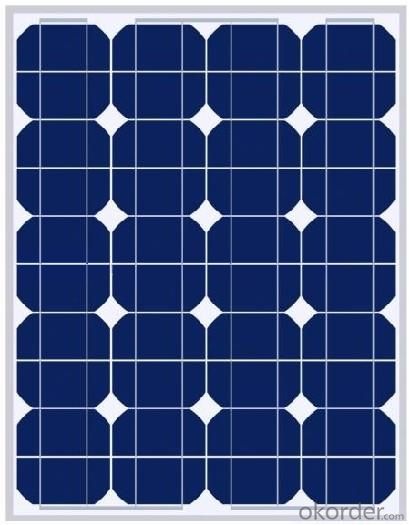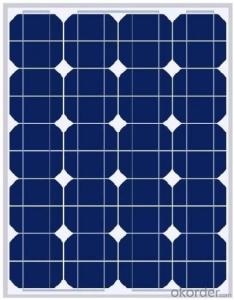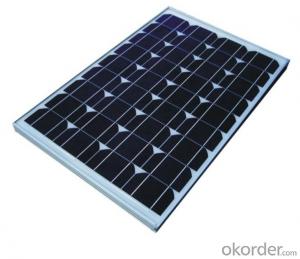Small Monocrystalline Solar Panel with 5W CNBM
- Loading Port:
- Qingdao
- Payment Terms:
- TT OR LC
- Min Order Qty:
- 10 set
- Supply Capability:
- 300000 set/month
OKorder Service Pledge
OKorder Financial Service
You Might Also Like
Small Monocrystalline Solar Panel with 5W


Quick Details
Place of Origin: | China (Mainland) | Brand Name: | CNBM | Model Number: | XRP-156M-250W |
Material: | Monocrystalline Silicon | Size: | 1620x992x40mm | Number of Cells: | 60 |
Max. Power: | 250w | Optimum Operating Voltage (Vmp): | 28.8V | Optimum Operating Current (Imp): | 8.68A |
Open Circuit Voltage (Voc): | 36V | Short Circuit Current (Isc): | 8.87A | Maximum Power at STC (Pmax): | 250W |
Operating Module Temperature: | -40 °C to +85 °C | Maximum System Voltage: | 1000 V DC (IEC) / 600V DC (UL) | Maximum Series Fuse Rating: | 15A |
Packaging & Delivery
Delivery Detail: | two weeks after order confirmation |
Features:
1) High Module conversion efficiency, through superior manufacturing technology
2) 0 to +5W positive tolerance for mainstream products
3) Certified to withstand high wind loads and snow loads
4) Anodized aluminum is for improving corrosion resistance
5) Anti-reflective, Highly transparent, low iron tempered glass
6) Excellent performance under low light environment
Benefit:
25-year performance warrant
10-year Product warranty
Electrical Characteristics:
Item No. | XRM-250W |
Optimum Operating Voltage (Vmp) | 28.8V |
Optimum Operating Current (Imp) | 8.68A |
Open Circuit Voltage (Voc) | 36V |
Short Circuit Current (Isc) | 8.87A |
Maximum Power at STC (Pmax) | 250W |
Cell Efficiency | 17.70% |
Operating Module Temperature | -40 °C to +85 °C |
Maximum System Voltage | 1000 V DC (IEC) / 600V DC (UL) |
Maximum Series Fuse Rating | 15A |
Power Tolerance | 0/+5 % |
STC: lrradiance 1000 W/m2, module temperature 25 °C, AM=1.5;
Best in Class AAA solar simulator (IEC 60904-9) used, power measurement uncertainty is within +/- 3%
Mechanical Characteristics:
No. of Cells | 60(6X10) |
Dimensions | 1640x992x40MM |
Weight | 20.0KGS |
Front | Glass 4.0 mm tempered glass |
Frame | Anodized aluminium alloy |
Temperature Characteristics:
Nominal Operating Cell Temperature (NOCT) | 45±2°C |
Temperature Coefficient of Pmax | -0.44 %/°C |
Temperature Coefficient of Voc | -0.33 %/°C |
Temperature Coefficient of Isc | 0.055 %/°C |
Refer to the Wmp range
Our factory can produce solar panel and solar module from 1.5W-290w (1.5w, 2.5w, 5w, 10w, 20w, 40w, 50w, 60w, 80w, 85w, 125w, 135w, 150w, 165w, 180w), according to customers requirement.
(A). Wmp range: 0.01W-6W, to be sealed with epoxy resin on PCB (printed circuit board), or to be sealed in plastic directly.
(B). Wmp range: 0.01W-15W, to be encapsulated with PET, on PCB (printed circuit board)
(C). Wmp range: 1W-60W, to be encapsulated with PET, on stainless steel, with holes for assembling purpose.
(D). Wmp range: 1W-290W, to be encapsulated with tempered glass, EVA, TPT, together with aluminium frame, junction box and (if necessary)diode and cable.
Refer to the material:
Monocrystalline solar cell or polycrystalline solar cell
Efficiency range 14%-17%, cell size 5/6.
- Q:Do solar panels require a battery backup system?
- No, solar panels do not require a battery backup system, but it can be beneficial to have one for storing excess energy for use during cloudy days or at night.
- Q:I live in a higher LATITUDE so in the winter months, there is a limitation in the amount of sunlight available, but will this impediment restrict the ability of solar panels to function due to the lack of sunlight involved?
- Solar panels generate power only during sunshine hours. But they only need sunshine, they don't like the heat, that comes along with the sunshine. So its a trade off, the places that have a lot of sun, also have a lot of heat, and places that do not have a lot of sun are not that hot. But you do need sunlight to run solar panels. There's a lot of tools available which can tell you how much power you are able to generate given your location.
- Q:What would these solar panels power? For instance, my energy bill shows 2035kWh for last month. How much would this remove from that if it outputted full power? Thanks!
- A solar panel that is rated at 60 watts would produce that amount under the most favorable conditions of direct sunlight at noon in a good location. This would taper off to nothing at the beginning and ends of the daylight. A 60 watt Panel operating at full output for hour would produce 60 watt hours. If we assumed a straight line of output from zero to 60 watts and back to 0 again over 6 hours the average output would be 30 watts x 6 hours = 80 watt hours / day x 365 days = 65700 watt hours in a year / 2 = 5475 watt hours in a month. You lose about 0% converting from DC to AC. This reduces this to about 4927.5 watt hours. Your bill is measured in KW hr which are 000 times bigger. This is 4.9275 KW hr or .24% of your last month's bill. At a national average of about $.2 per KW hr the energy out put for one month would be equal to about 60 cents.
- Q:I was trying to look online for solar panels for my home to take some of the strain off of using oil and electricity but I find it very hard to understand exactly how they are used.Like one that I looked up is 00 watts.....is that like a light bulb watt? How many things can that power? Is it really cheaper in the long run because the panels are very expensive?If anyone has web sites that can explain this to me I would appreciate a link, or anyone to answer part of my question.
- Solar okorder /
- Q:Can solar panels be installed on outdoor event venues?
- Yes, solar panels can be installed on outdoor event venues. Solar panels are versatile and can be mounted on various surfaces, including rooftops, canopies, and even the ground. Installing solar panels on event venues can help generate clean and renewable energy, reducing reliance on traditional power sources and minimizing carbon emissions. Additionally, solar panels can provide shade and protect attendees from the sun, creating a more comfortable environment during outdoor events.
- Q:Are there any maintenance requirements for solar panels?
- Yes, solar panels do require some maintenance. Regular cleaning to remove dust and debris is recommended to maximize their efficiency. Additionally, inspecting the panels for any signs of damage or wear, and ensuring proper wiring and connections, are important maintenance tasks.
- Q:Can solar panels be installed on a boat or RV?
- Yes, solar panels can be installed on both boats and RVs. They provide a sustainable and efficient source of energy, allowing for off-grid power generation while traveling or moored. The panels can be mounted on the roof or other suitable areas to capture sunlight and convert it into electricity to power various onboard appliances and systems.
- Q:How do solar panels affect the property's community engagement?
- Solar panels can positively impact a property's community engagement by promoting sustainability and renewable energy. They serve as a visible and tangible example of the property's commitment to reducing its carbon footprint, which can inspire others in the community to adopt similar practices. Additionally, solar panels often generate excess energy that can be shared with the community, fostering a sense of collaboration and local energy independence.
- Q:Can solar panels be installed on public transportation systems?
- Yes, solar panels can be installed on public transportation systems. In fact, many cities around the world are increasingly integrating solar panels onto buses, trams, and trains to harness clean energy and reduce carbon emissions. These panels can be installed on the roofs or sides of vehicles, enabling them to generate electricity and contribute to the power needs of the transportation systems.
- Q:Hello from SO TX.. I would like to know if anyone out there has SOLAR PANELS on their home?I have a 850 sq ft. house. I called Austin to a company that offers panels and installation. The cost $8,000.00, for 0 panels . The rep said we would save about 2 to 25% on our electric bill /mo. We use approximately 980 kw/mo. Our bill is around $40.00 / mo...I really don't think that's a good enough savings. We figure it would take 25 years to recoup our investment.And where we live in TX it does not offer any incentives. The gov. allows you a $2000.00 tx break.
- $8,000 invested at 5% interest would pay you $900 per year for the rest of your life. If you spend $40 per month and would save 25% of that, you would save $420 per year. To be fair, the savings would creep up with the electric rates but this would be off-set by maintenance cost and equipment attrition.
1. Manufacturer Overview |
|
|---|---|
| Location | |
| Year Established | |
| Annual Output Value | |
| Main Markets | |
| Company Certifications | |
2. Manufacturer Certificates |
|
|---|---|
| a) Certification Name | |
| Range | |
| Reference | |
| Validity Period | |
3. Manufacturer Capability |
|
|---|---|
| a)Trade Capacity | |
| Nearest Port | |
| Export Percentage | |
| No.of Employees in Trade Department | |
| Language Spoken: | |
| b)Factory Information | |
| Factory Size: | |
| No. of Production Lines | |
| Contract Manufacturing | |
| Product Price Range | |
Send your message to us
Small Monocrystalline Solar Panel with 5W CNBM
- Loading Port:
- Qingdao
- Payment Terms:
- TT OR LC
- Min Order Qty:
- 10 set
- Supply Capability:
- 300000 set/month
OKorder Service Pledge
OKorder Financial Service
Similar products
New products
Hot products
Hot Searches
Related keywords




























